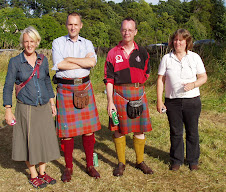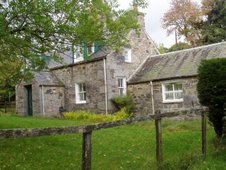A bit forrader. The overhead
light in the kitchen – where I spend a lot of time huddling – went out on
Saturday. Archie came round to help, and in the process of extracting the dead
bulb, pulled it apart, so that the metal sleeve remained in the socket. Today
my very dear electrician came and put things right. So I can huddle again.
But I mustn’t. If I am to offer
Jenna the option of a small lace shawl of her own for her wedding in July, I must get on briskly with
the Stronachlachar. You’re right, Marion, that it is Jared’s Rock Island that I
am thinking of. (You must start your Rosemary Shawl at once – you’ll love it once you get going.) I have been wondering
whether I could make it a bit fancier, with another lace motif instead of all
that garter stitch at the end; or whether I could plan a small triangular shawl
of my own from scratch.
Would Liz Lovick’s “Exploring
Shawl Shapes” help? I’ve got a couple of her books, but not that one.
I could buy Jared’s pattern and
use it as a template.
Meanwhile, Mary Lou, please
follow up your thought about the stuff that might whiten Hellie’s shawl. Or I
could Google it myself.
Sarah, when I embarked on
Sharon Miller’s “Princess” shawl, I didn’t have a bride in mind, or indeed in
prospect. I would highly recommend just plunging in. If you are still around to
see someone wear it, think how pleased you will be! And if not, think how they
will all remember you on that happy day!



Rock Island is very pretty. I saw this person just repeated the lace pattern to increase the lace-to-plain ratio. Maybe a simple option with great result?
ReplyDeletehttps://www.ravelry.com/projects/raparker99/rock-island-2
Beverly in NJ
Why not have a look around Ravelry? There are many exquisite shawls there and an astonishing number of the patterns are free!
ReplyDeleteAs for the yellowing wool, I recommend contacting the firm who made the yarn. Google brings up various suggestions, most involving white vinegar and / or hydrogen peroxide solutions. They all recommend testing on a scrap of fabric or yarn before using it on the main garment. The problem is that you don't know what processes have been used on the yarn and you definitely do not want an adverse reaction. This article is informative
http://textilelearner.blogspot.com/2011/03/bleaching-process-of-wool_6885.html
One of the rare things I recall from my tussles with 'O' level Latin is Candidatus = clad in a pipe-clayed toga. Those seeking election wanted a bright white toga, not the ordinary one bleached by suspending the damp fabric over burning sulfur. (This practice has many perils!) Neither process is appropriate for the shawl.
The only helpful thing I can think of is to consult the manufacturer.
Helen (anon)
Liz's book is useful for beginner designers but there is also Melissa Leapman's "Knitting Modular Shawls, Wraps and Stoles" (2018)Storey, MA
ReplyDeleteIt is called Orvus Paste, and is sold online, in quilt shops, and farm stores around here. It might be worth a try. I imagine you have a bit of the yarn around. It can't be used on silk.
ReplyDeleteI've knit Rock Island and it is a fascinating and rather a fast knit, even for slowpoke me. There is lace work on both sides - none of that purl-or-knit-back-every-other-row stuff for Jared, and I found that I had to pay attention while knitting the edging.
ReplyDeleteAre you huddling for warmth, or just because the kitchen is a comforting environment with tea readily available? In either case, I recommend the adoption of a "house hat" - even a little lacy thing that wouldn't stop the slightest breeze helps keep me warmer indoors.
ReplyDeleteI have had some success restoring yellowed linens with a product called “Restoration”, available from Lacis, a specialty specialty shop/lace museum in Berkeley, CA. (http://lacis.com/catalog/). “Restoration Cleaning Agent
ReplyDeleteA powered gentle, long soak cleaning agent, specifically formulated for antique linens and lace. Environmentally safe, suitable for all fabrics and a remarkable stain remover, specifically the acid stains caused by long storage in an acid environment.”
It is rather pricey, but may prove worth the effort for such a treasured family heirloom.